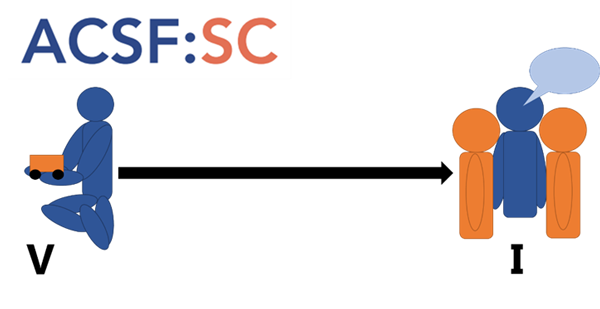ACSF:SC Study: In Brief
ACSF:SC (Autism Classification System of Functioning: Social Communication)
In Brief © Briano Di Rezze & Peter Rosenbaum, 2017
What was this study about?
The overall purpose of this study was to create a way to classify ‘levels’ of social communication abilities of preschool children with Autism Spectrum Disorder, focusing on what they can do rather than on their deficits.
Why study the classification of social communication in autism?
Autism Spectrum Disorder (ASD) refers to a group of neurodevelopmental conditions that are characterized by two main challenges: difficulties with social communication, and repetitive stereotyped behaviours. There are a number of clinical measures that assess a child’s behaviours and development to help determine if they have ASD. With rare exception these measures do not categorize the ‘severity’ of the child’s ASD; provide a clear picture of their level of functioning; or tell us how to group different levels of functioning. Most of these measures are not specific to social communication and many are based on what a child cannot do. Looking at what a person can do will help us to better understand a child’s potential for improvement. The CanChild study team wanted to create a scale that could be used to describe the levels of social communication ability of kids with ASD.
How did the researchers study this topic?
The researchers started by asking the following questions:
- Can we develop a way to describe levels of ability to communicate socially in preschool kids with ASD (between their 3rd and 6th birthdays)?
- Is the scale simple for parents, educators, and clinicians to use?
- Is the scale ‘reliable’ (consistent when used by different people and in different places) and ‘valid’ (are the levels meaningfully different from one another)?
The study was done in two steps. During Step 1, the researchers wanted to determine the content of the classification system by asking the people best able to describe communication in kids with ASD. To do this they asked parents, doctors, therapists and early childhood teachers who work with preschoolers with ASD to describe social communication of children with ASD in everyday life, and the different kinds of communication abilities demonstrated by these children. From their answers the researchers created a first version of their tool – the Autism Classification System of Functioning: Social Communication (ACSF:SC). Then they asked a new group of parents, doctors, therapists and teachers to provide feedback (to check on whether things made sense to these new experts) and then made further revisions. This process took many months and involved over 75 people both locally and around the world.
From this work, social communication was defined as the ability to communicate (with or without words) in order to interact with other people.
What does the ACSF:SC look like, and what does it do?
The ACSF:SC categorizes preschoolers with ASD into 5 levels based on how well they can communicate socially. Children in Level V have the least developed social communication ability, and children in Level I demonstrate the highest developed social communication ability. Thus, children in Level V tend to play by themselves and may only be understood by their primary caregiver or experienced therapist. On the other hand, children in Level I may be observed to initiate and respond for social purposes about more than just their preferred interests/activities, and be able to do this with most people. The diagram below shows what the range of ACSF:SC Levels from V and I might look like. On the ACSF:SC, the child is rated (from V to I) twice by considering their abilities under two conditions: Capacity (best performance in optimal environmental and contextual conditions) and Typical Performance (average performance on a daily basis).

So, was it then ready to be used?
Before any tool like the ACSF:SC can be used with confidence, researchers have to make sure it ‘works’ (Step 2). To do this for the ACSF:SC, the researchers had parents, doctors, therapists and teachers use the tool to classify 41 children with ASD between the ages of 3 and 6 years. Data showed that raters completing the ACSF:SC demonstrated high levels of accuracy (89% to 100%) when they followed the instructions in the ACSF:SC User Guide. 77% of parents and 92% of professionals found the ACSF:SC useful. 92% of parents and 97% of professionals found it easy to match the child’s abilities to a level within the ACSF:SC. Researchers also compared the scores of the parents, doctors, therapists and teachers to assess whether they were usually the same. Most of the ratings were similar or very close, so the tool is reasonably ‘reliable’ (meaning people use it in a way that is consistent with each other). Data also showed that the tool was accurate in capturing the concept of social communication based on the DSM-5 definition. Further testing of the accuracy of the ACSF:SC is underway as this current research step is typically an ongoing process.
What did we learn?
- The ACSF:SC is simple to use and accurate for children with ASD between 3 and 6 years.
- The ACSF:SC can be used consistently by parents, doctors, therapists and teachers.
- Social communication functioning in ASD can be described in 5 levels of ability focused on what a child with ASD can do.
How might the ACSF:SC be applicable in the field of ASD?
Given that the ACSF:SC describes levels ‘social communication’ in children 3-6 years with ASD, we believe it will have several uses for both clinical services and for research:
(i) Achieving educational/clinical goals.
Parents, doctors, therapists and teachers often do not use the same language when talking about the social communication ability of kids with ASD. The ACSF:SC is a stepping-stone to enable everybody to describe the same thing in the same way. When this happens, information can more easily be shared between parents and professionals, and among professionals. When parents and professionals work together they understand each other better and focus on ability. This may allow them to better plan how best to work on meaningful functional goals, including social communication.
(ii) Improving ASD research and interventions.
It is important when people are conducting research studies that they involve and study groups of people who are similar to one another (so they compare things fairly). The ACSF:SC makes it possible to identify children with similar social communication abilities for future research on ASD. It can also help researchers decide if some therapies are better for kids with certain levels on the ACSF:SC if they can look at their ability patterns over time.
What are our current and future steps for the ACSF:SC?
At CanChild we are currently planning the following new studies:
- Looking at whether a child’s ACSF:SC level changes over their preschool years.
- Looking to develop and test age-specific versions of the ACSF:SC for children with ASD (especially for children younger than 3 and older than 6 years old).
- Exploring whether we can predict the ACSF:SC level based on scores from diagnostic tools like the Autism Diagnostic Observation Schedule (ADOS) and the Childhood Autism Rating Scale (CARS) that are routinely used in the assessment of children with possible ASD.
Where can you access information about the ACSF:SC?
More information about this study - the development, testing, and ongoing research with the ACSF:SC – is available on the CanChild website.
For more information, please contact Peter Rosenbaum at canchild@mcmaster.ca
Acknowledgements
We would like to thank Julia Hanes for her assistance in the development of this 'In Brief'. Special thanks to Connie Putterman and JoAnne Mosel for critically reviewing this document.
